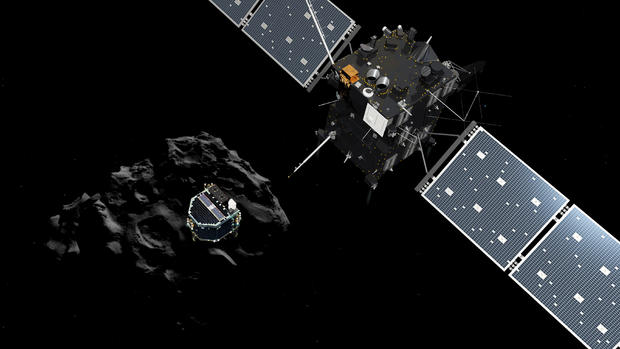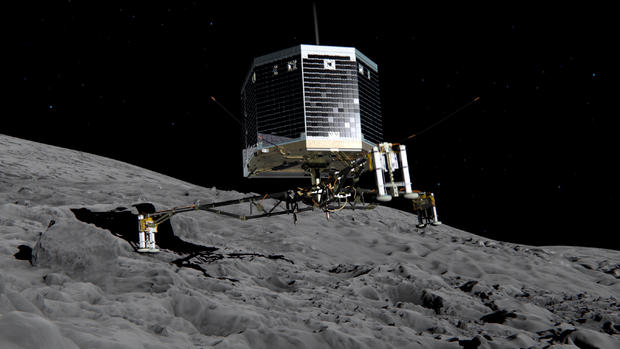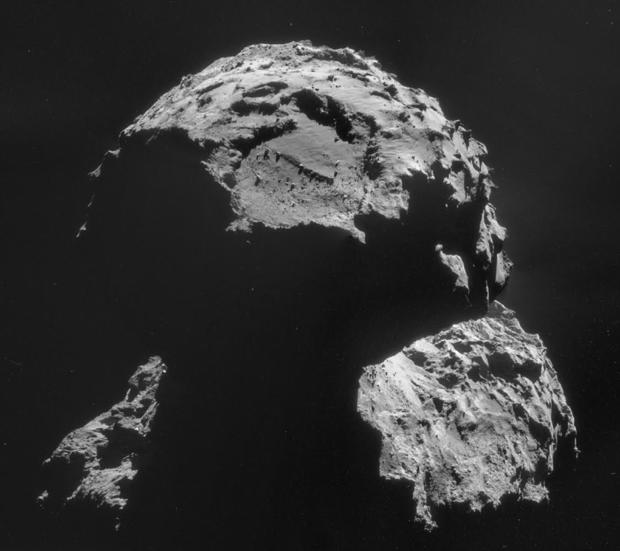Comet lander may have bounced
The drama played out 317 million miles from Earth as a small robotic lander released from the European Space Agency's $1.7 billion Rosetta probe touched down Wednesday on Comet 67P/Churyumov-Gerasimenko, the first such landing in history. After a seven-hour descent, the Philae lander gently collided with the slowly tumbling comet, possibly bouncing off and then settling to a second landing a short distance away, officials said.
Or maybe not. It was not immediately clear what happened during landing, where the Philae spacecraft ended up or how stable it might be in Comet 67P/Churyumov-Gerasimenko's feeble gravity. But mission managers said the otherwise healthy lander was making science observations as programmed and engineers were optimistic about figuring out its status in the coming days.
In the meantime, Jean-Jacques Dordain, director general of the European Space Agency, urged the media and the public to give engineers time to study the data before jumping to conclusions.
"We landed, and Philae survived the landing," he said. "We have landed at the right place -- on the right comet, don't worry! -- and we have got the radio link, which is obviously very important, and we have the power on board. So when you have the link and the power, you collect data, and this is what our colleagues are doing.
"Now, the data have to be analyzed," he cautioned, adding that engineers were only a few hours into diagnosing events happening several hundred million miles away. "I wish that we are careful, because we are just at the beginning of something which will last (a) long (time) and again, we have time. Now we have just to work."
As expected, the Philae lander hit the two-and-a-half-mile-wide comet at a walking pace, a bit more than 2 mph, around 10:35 a.m. EST (GMT-5). Radio signals confirming touchdown reached flight controllers at the European Space Operations Center in Darmstadt, Germany, 28 minutes later.
A cold gas thruster was programmed to fire at the moment of landing to help push Philae down while two harpoons shot into the soil to anchor the spacecraft in place. The harpoons and ice screws on the bottom of each landing leg were needed to help keep the spacecraft from bouncing off in a gravity field 100,000 times weaker than Earth's.
But the thruster system did not pressurize during overnight activation and engineers confirmed it did not fire during landing. In addition, the harpoons apparently failed to deploy as planned to anchor the spacecraft on the surface. Examining telemetry, engineers saw indications the lander might have bounced up and then settled back to a second touchdown nearby.
"It's complicated to land on a comet," said Stephan Ulemac, the Philae landing team director. "And it's not only complicated to land there, it's also, as it appears, very complicated to understand what has happened during this landing. What we know is we touched down, we landed at the comet at the time when you all saw us cheering. We had a very clear signal there, and we also received data from the lander, housekeeping data and also science data.
"That's the very good news. Not so good news is that the anchoring harpoons apparently did not fire, so the lander is not anchored to the surface," he said. "We started to think about what could be the situation. Did we just land in a soft sandbox, and everything is fine although we are not anchored? Or is there something else happening?"
The radio link with the lander was intermittent, stopping and restarting at different intervals and solar power levels fluctuated, possibly indicating movement.
"Some of these data indicated that the lander may have lifted off again," Ulemac said. "So maybe today we didn't just land once, we landed twice!"
Rosetta dropped behind the comet late in the day, as expected, interrupting communications with the lander. Engineers were hopeful that by the time contact was re-established early Thursday they would have a better idea of what had happened during landing and a better sense of the spacecraft's long-term stability.
The landing sequence began seven hours earlier, around 3:35 a.m., when the Rosetta mothership released Philae for a slow, seven-hour descent to 67P/Churyumov-Gerasimenko.
The lander was not equipped with a hazard avoidance system or thrusters to change its trajectory. And given the comet's vast distance from Earth, there was no way for flight controllers to actively guide the craft during final approach. From the moment of release from the Rosetta mothership, Philae was on its own, bound for a touchdown somewhere in a 1,600-foot-wide landing zone.
The overnight failure of the landing thruster raised the already high anxiety in the European Space Operations Center, where flight controllers, mission managers and scientists nervously waited out the long descent and telemetry relayed through Rosetta confirming Philae's touchdown.
Technical issues aside, the team could only hope Philae would not come down on a boulder or a steep slope that might tip the lander over or send it careening back out into space.
But as it turned out, Philae's trajectory was spot on, carrying it to the center of the planned landing zone. Telemetry confirming touchdown prompted an outburst of cheers and applause as the mounting tension of the past week evaporated with welcome release.
"We can definitely confirm that the lander is on the surface!" said Andrea Accomazzo, Rosetta spacecraft operations manager. He then called in Stephan Ulamec, director of the Philae landing team at the German space agency.
At the time, Ulamec said the harpoons had fired and rewound and "we are sitting on the surface. ... We are on the comet!"
Another round of applause and cheers greeted the announcement, not to mention a wave of relief that one of the most complex landings ever attempted in deep space, one fraught with unknowns and a narrow margin of error, had apparently succeeded, a high-tech triumph for the European Space Agency.
But within the hour, engineers studying telemetry realized they were unable to confirm whether the harpoons fired, leaving the lander's status uncertain. Additional analysis eventually led Ulamec to speculate that Philae might have bounced down. In any case, scientists and engineers were optimistic given the lander's systems remained operational despite the uncertainty about its stability.
While comets have been studied from afar by a variety of U.S. and European spacecraft, Rosetta and Philae represent the first attempt to fly in tandem with a comet as it approaches the sun and to drop a probe to its surface for in situ observations.
"Rosetta is the sexiest science mission, the sexiest space mission that's ever been," mission scientist Matt Taylor said earlier. "We're going to ride alongside this comet, we're going to have a ringside seat as we go from this rather inert object now through perihelion, that's closest approach to the sun next year, and as it starts to move away from that sun. ... It's going to be an awesome ride."
Philae is equipped with 10 sophisticated instruments and cameras. A 360-degree panorama was planned to give scientists a detailed look at the landing site, along with microscope views of the soil directly beneath the lander.
Assuming it will not displace the lander in the absence of its anchors, a drill will penetrate a foot below the surface to collect pristine material for chemical analysis. Other instruments will sample the dust given off by the comet, study its internal structure and monitor how it changes as 67P moves closer to the sun.
Rosetta, meanwhile, will relay Philae's data back to Earth and carry out science observations of its own using a suite of 11 cameras and other instruments. ESA hopes to operate Rosetta through the end of 2015 to characterize the comet's behavior as it approaches the sun and then begins heading back out into deep space.
But that assumes Philae is healthy and remains in place on the comet's frigid, low-gravity surface.
NASA contributed three instruments to Rosetta and relayed telemetry to ESA from the agency's globe-spanning Deep Space Network. Jim Green, director of planetary science at NASA headquarters, could barely contain his excitement.
"How audacious!" he exclaimed. "How exciting! How unbelievable, to be able to dare to land on a comet, to take that step that we have all wanted from a scientific perspective. this mission that ESA has produced and given aback to the world in this venue has allowed us all to participate in that great adventure. We should relish that moment."
Calling the Rosetta mission and Philae's landing "the start of something important," Green said "it's our destiny to move off this planet. And this is the kind of step that we must do. ESA, thank you from the bottom of my heart for a wonderful experience. And the science will be marvelous!
Discovered in 1969, 67P/Churyumov-Gerasimenko circles the sun in an elliptical orbit extending nearly 500 million miles from the sun at its far point -- beyond the orbit of Jupiter -- to a point between the orbits of Earth and Mars some 115 million miles from the sun. The comet measures 2.5 miles across and rotates every 12.4 hours, taking about 6.5 years to complete one orbit.
During Rosetta's approach earlier this year, scientists finally got a high-resolution look at its target, revealing a bizarre body with two bulging lobes connected by a thinner neck-like region. The comet's unusual structure posed a variety of challenges for Philae's landing, ranging from towering cliffs to huge boulders strewn across a complex, tortured-looking terrain.
Like all comets, 67P/Churyumov-Gerasimenko is a frozen remnant of the primordial material used to form the sun and planets 4.6 billion years ago. Comets may have delivered water to Earth and along with it, organic compounds that may have played a role in the development of life.
"When the solar system was forming out of gas and dust, it formed the planets, the one we live on today, it formed asteroids and it formed the comets," said McCaughrean. "And the comets are a remnant, therefore, something we can investigate about the very earliest phases of the evolution and the birth of our own solar system."
The ice found in comets can "give us great clues to the origin not only of our own solar system, but potentially even life," he said. "Because we know that comets also contain organic molecules, the building blocks of even DNA and RNA. We know that there are amino acids in comets, for example. So comets play a key role in our understanding of the cycle of star formation, planet formation, perhaps life formation."
Launched on March 2, 2004, Rosetta had to carry out four planetary flybys, using the gravity of Earth and Mars in repeated passes to pump up the spacecraft's velocity enough to move out into deep space and catch up with 67P/Churyumov-Gerasimenko.
On the way, Rosetta flew past two asteroids, sending back high-resolution pictures and other observations, and spent two-and-a-half years in electronic hibernation while it closed the gap with its target. On Jan. 20, Rosetta woke itself up for the final leg of its journey, matching 67P's orbit on Aug. 6 and setting the stage for Philae's landing.
A major unknown throughout the approach phase was the nature of the eventual landing site. Comet 67P/Churyumov-Gerasimenko is a much more challenging body than anyone anticipated when Rosetta was launched in 2004 and engineers had no guarantees that Philae would avoid landing on a boulder or a steep slope that might prevent a successful touchdown.
"If you decide you're going to land on an object you know nothing about 10 years, 20 years ago, then you run risk," Fred Jansen, the Rosetta mission manager, told reporters Tuesday. "It's not a nice, round potato, it's rough, it's more difficult. But we've analyzed the terrain, we've analyzed the comet, and we're confident that the risks we have are still in the area of 75 percent success."
Putting the landing in perspective, he said Rosetta's observation will amount to about 80 percent of the expected science return for the overall mission while Philae's contribution, if successful, will be about 20 percent.
"Of course, we are here for the landing," he said. "But we shouldn't forget that Rosetta has a mission. It's already done a vast amount of science. ... The landing will be the cherry on the cake, connecting what we see in orbit with what we see on the ground."



